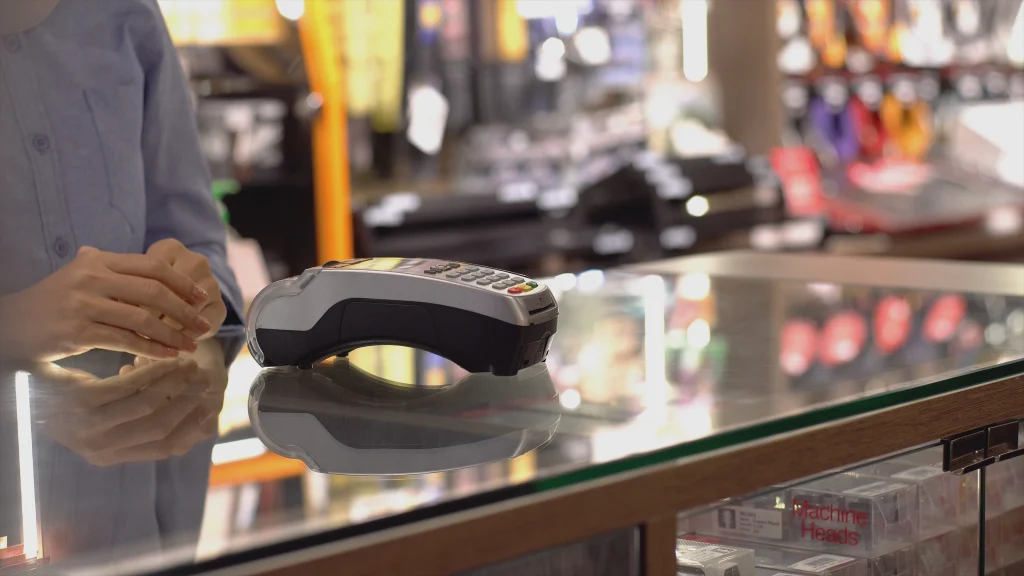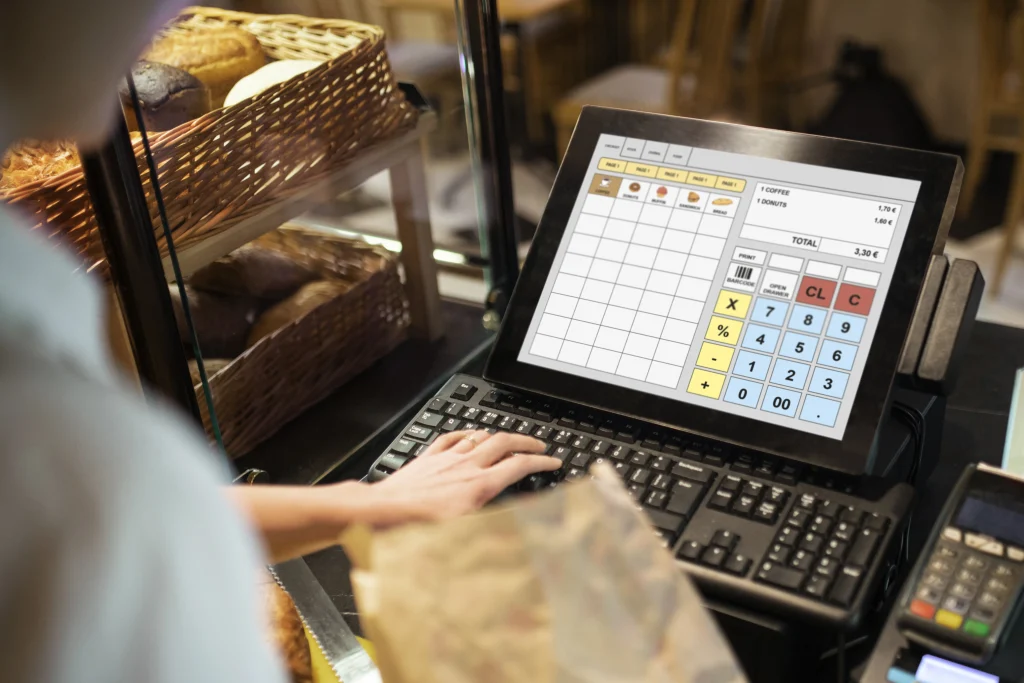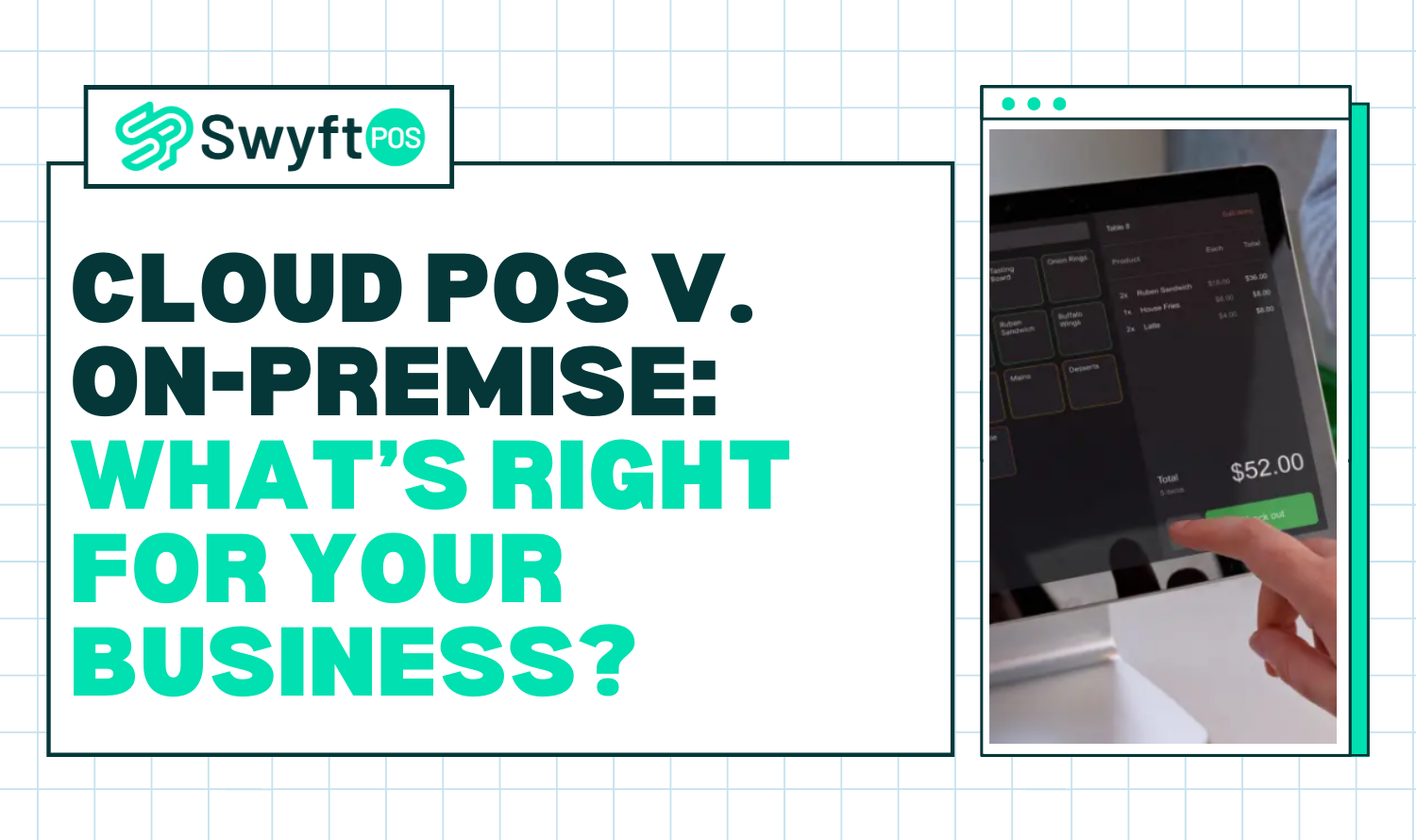Choosing the right Point of Sale (POS) system can define how efficiently your business operates. Whether you manage a small retail shop or a multi-location restaurant, the decision between the best cloud-based retail POS and an on-premise POS affects your operations, costs, scalability, and security.
This guide will break down the differences, highlight pros and cons, and help you make an informed decision based on your business needs.
What is a POS System?
A POS system allows a business to process customer transactions. But modern POS platforms do more than accept payments. They often include tools for:
- Inventory management
- Sales reporting
- Employee performance tracking
- Loyalty programs
- Customer relationship management

Understanding the delivery models — Cloud and On-premise — is essential to choosing the right system.
Cloud POS v. On-premise POS: A Quick Overview
Let’s look at the fundamental differences between the two systems; cloud-based POS software and on-premise POS.
| Feature | Cloud POS | On-premise POS |
| Installation | Runs through the internet | Requires physical installation |
| Accessibility | Accessible from any location | Limited to the store’s network |
| Updates | Automatic from provider | Manual, often requires downtime |
| Cost | Monthly or annual subscription | One-time license plus upkeep |
| Data Storage | Cloud servers | Local storage |
| Internet Dependence | Required | Not always necessary |
| Scalability | Easy to scale | Needs additional hardware |
| Security | Managed by vendor | Managed in-house |
Understanding On-premise POS
An on-premise POS stores all data on local servers. The business owns and controls both the hardware and software. This setup works well for companies that prefer full control of their IT infrastructure.
Advantages of On-premise POS
- Full control of data security and compliance
- Minimal dependence on internet access
- Highly customizable for industry-specific workflows
Drawbacks of On-premise POS
- High upfront cost for hardware and software licenses
- Requires dedicated IT staff for maintenance
- Manual updates and backups
Understanding Cloud POS
A cloud-based POS software operates over the internet and stores data in secure cloud environments. These systems often work on tablets, smartphones, or standard computers.
Advantages of Cloud POS
- Quick setup with minimal hardware requirements
- Accessible from multiple locations or devices
- Automatic updates and backups
- Lower upfront costs
Drawbacks of Cloud POS
- Heavily reliant on stable internet connectivity
- Monthly subscription fees can add up over time
- Less flexibility in deep system customization
Cloud POS v. On-premise POS
Choosing between cloud and on-premise POS isn’t just about one factor — it’s a mix of cost, features, security, and scalability. Each system has strengths that suit different types of businesses, so looking at them side by side makes the trade-offs much clearer.
Cost Comparison
Understanding the cost differences helps you manage budget expectations. Here’s a sample breakdown:
| Cost Factor | Cloud POS (Annual) | On-premise POS (Year 1) |
| Licensing | $1,200 | $3,000 |
| Hardware | $500 (optional) | $2,000 |
| Maintenance | Included | $1,000 |
| IT Staffing | Minimal | Required |
| Total | ~$1,700 | ~$6,000+ |
Cloud POS involves a lower upfront investment. On-premise POS may cost more initially, but it becomes less expensive in the long run if no major upgrades are needed.
Features and Flexibility
The best cloud-based retail POS system comes with multiple features and flexibilities, let’s have a look at them!
Customization and Control
- On-premise systems offer deeper customization options. Developers can access source code or backend settings.
- Cloud POS usually follows vendor constraints. Users can modify settings but within limited parameters.
Integration with Other Tools
Cloud POS systems easily connect with:
- eCommerce platforms
- Accounting software
- Email marketing tools
- Loyalty and CRM systems
On-premise POS may support integrations but often requires manual development or middleware, which adds cost and complexity.
Data Access and Reporting
With Cloud POS, you can view real-time data from any device. You can track sales trends, monitor inventory, or check employee performance without visiting the store.

On-premise systems limit data access to the local network. You may need to export reports manually or use VPNs for remote access, which complicates the process.
Security and Compliance
When handling customer payments, security isn’t optional — it’s essential. Both cloud and on-premise POS systems can be secure, but the responsibility for managing that security falls in very different places.
Cloud POS Security
Most cloud providers follow strict security protocols:
- End-to-end encryption
- Role-based access control
- Automated backups
- PCI compliance
The provider manages all patches and security updates, removing much of the burden from your team.
On-premise POS Security
Security lies entirely in your hands. You must maintain:
- Firewalls and antivirus tools
- Manual data backups
- PCI DSS compliance audits
- Disaster recovery plans
While some businesses prefer this control, it requires dedicated personnel and increases risk if not managed properly.
Downtime and Reliability
No POS system is immune to disruptions. The difference lies in what causes downtime — and who’s responsible for getting things back online.
Cloud POS Risks
If your internet goes down, the system may stop functioning unless it has an offline mode. Even then, certain features (like real-time syncing) may not work.
On-premise POS Risks
Hardware failures, power outages, or local server issues can cause significant downtime. You must have backup systems in place, which increases cost and complexity.
Scalability and Growth Potential
As your business grows, your POS system needs to grow with it. The ease of scaling depends heavily on whether you’re using a cloud-based or on-premise setup.
Scaling with Cloud POS
Adding a new location or register is simple. You can:
- Set up new devices with login credentials
- Manage all stores from a single dashboard
- Maintain centralized inventory and reporting
Scaling with On-premise POS
Scaling requires:
- Installation of new hardware at each site
- Manual data synchronization
- Complex software licensing
This setup slows down expansion and increases technical overhead.
Best Use Case Scenarios
Choosing between cloud and on-premise POS often comes down to business needs. Each model shines in different situations, depending on size, resources, and priorities.
Cloud POS is ideal for:
- Small and medium businesses
- Startups with limited budgets
- Multi-location retailers
- Seasonal pop-up shops
- Mobile or delivery-based services
On-premise POS is ideal for:
- Large enterprises with internal IT departments
- Restaurants and hotels that need offline reliability
- Regulated industries that require local data control
- Organizations with long-term technology infrastructure plans
Pros and Cons Summary
Both cloud and on-premise POS systems come with unique advantages and challenges, so it’s important to weigh them side by side before deciding which fits your business best.
Cloud POS
Cloud POS brings speed and simplicity to the table, though not without a few strings attached.
Pros:
- Fast deployment
- Remote access
- Low upfront cost
- Easy updates and integrations
Cons:
- Requires stable internet
- Monthly or annual fees
- Limited customization
On-premise POS
On-premise POS comes with its own set of strengths and drawbacks.
Pros:
- Greater data control
- Offline reliability
- Custom system features
Cons:
- Expensive hardware and licensing
- IT expertise needed
- Manual maintenance
Final Checklist: Which POS Is Right for You?
Consider these questions before deciding:
- Do you need remote access to your POS data?
- Is your internet reliable across all business locations?
- How much are you willing to invest upfront?
- Do you have IT staff to manage software and servers?
- Will you need to scale quickly or open new locations soon?
- Are you looking to integrate the POS with other software?
Final Takeaway
Both cloud and on-premise POS systems offer distinct advantages. Cloud POS systems suit businesses that value flexibility, quick setup, and remote access. On-premise systems work better for companies that need full control, deep customization, and local data security. The right choice depends on your business goals, resources, and growth plans.
If you’re scaling fast or need total control, Swyft POS has the right solution for your business. Explore our Cloud and On-premise options and see how we can simplify your operations and boost efficiency. Schedule a free demo today to find your perfect fit.
Frequently Asked Questions
1. What is the main difference between Cloud POS and On-premise POS?
Cloud POS stores data online and requires internet, while On-premise POS stores data locally and operates without the cloud. The choice depends on your business needs and infrastructure.
2. Is Cloud POS secure for handling customer data?
Yes, reputable Cloud POS providers use encryption, backups, and follow PCI compliance standards. Security is managed by professionals, often better than in-house setups.
3. Can I switch from On-premise to Cloud POS later?
Yes, migration is possible but requires data transfer, system integration, and staff retraining. Planning with support from both vendors ensures a smooth transition.
4. Does Cloud POS work without internet access?
Many Cloud POS systems have offline modes that allow basic operations. However, features like syncing, reporting, and online payments may be limited.
5. Which POS system is more cost-effective in the long run?
Cloud POS has lower upfront costs but ongoing fees, while On-premise requires higher initial investment but fewer recurring charges. Total cost depends on your business size and growth.





